- Ayurvedic Guide to Summer Wellness
- Top 10 Ayurvedic Foods for Summer Health
- Living the Water Conservation Way
- Why you need a Ayurvedic solace in Kerala ?
- Beyond the Room: How Niraamaya Champions Local Experiences
- A Tale of Two Indian Spots for Valentine's Day
- Unlock a Stress-Free Life: 6 Reasons to Choose Wellness Retreats
- From Ayurveda to Modern Medicine: Hibiscus Across the Globe
- The Ayurvedic Wellness : 7 Tips to Transform Your Health
- A Year of Self-Care: The Ultimate Guide to Rejuvenation Holidays
- Experience the Hornbill Festival: A Cultural Marvel
- How Nature-Friendly Rooms Enhance Sleep Quality
- Wellness Through Design
- Beyond the Boardroom: A Guide to Corporate Wellness Success!
- Kannur: A Wellness Oasis in Kerala
- No-Fire Cooking: A Sustainable and Delicious Culinary
- A Diwali Trip Guide to Kerala
- Ghee, An Ayurvedic Superfood for Auspiciousness and Nourishment
- Unlocking the power of Better Sleep: A Path to Wellness
- Pomegranate Juice: 10 Health Benefits of the Red Pearl Fruit
- The Ayurveda Way: 10 Power Foods for Diabetes
- Roar for Tigers: The world needs more species!
- Experience Niraamaya Retreats Private Residencies At Least Once!
- Why India Is Our New Favorite Place for Medical Tourism
- 5 Reasons to Visit Niraamaya Retreats in Monsoon
- Complete Guide to Surviving Monsoon Depression with Niraamaya
- Embrace the Healing Power of Karkidaka Chikitsa
- Embracing the Kaleidoscope of Love
- Discover the World of Teas and Tisanes
- The Jackfruit Biryani Phenomenon: Why Everyone is Talking About
- From Limiting Beliefs to Limitless Possibilities
- From Chaos to Calm: Celebrating Stress Management Month
- Small Steps, Big Impact: Celebrating Earth Day at Niraamaya Well
- Make a Splash this Summer in Niraamaya’s Private Pool Villas
- Niraamaya Wellness Retreats’ Mussels Ulathiyathu
- Locally Sourced, Freshly Prepared: Exploring Zero-Mile Cuisine a
- Finding Your Zen: Ayurvedic Techniques for a Calmer Mind
- From Farm to Table: Embracing the Slow Food Movement
- Spice Up Your Seafood with Niraamaya's Squid Pepper Recipe
- Plan your next Wellness-cation with Niraamaya Retreats
- Navigating the World of Ayurveda
- Bitter but oh-so-good: Pavakka Thoran
- Unleash Your Inner Wellness Warrior
- The Ultimate Relationship Booster
- Uncovering India's Gems: A Zodiac-Based Guide - Part 2
- Uncovering India's Gems: A Zodiac-Based Guide
- Top Destinations to Visit in 2023 with your Partner
- Safety First: A Guide to Solo Travel for Women
- The Secret to Niraamaya’s Signature Travancore Fish Curry
- Capture the Holiday Magic With Niraamaya's Festive Offerings
- The Ultimate Guide on how to end the year in style at Seychelles
- Athirappilly 101: A beginner's guide on how to have an unforgett
- 7 Reasons Why Stress Management is the Key to a Healthier Life
- Check out the Health Benefits of these 10 Ayurvedic Herbs
- Start Your Wellbeing Journey with These 6 Simple Tips!
- Express yourself via the Art of Journaling
- Leverage cutting-edge tech for advanced wellness
- Boost your post-COVID recovery with Niraamaya
- Make A Positive Change With Our Simple Summer Swaps
- Five tips to help you maintain good health during summer
- 5 Must-Do Wellness Tips In 2022
- Vegan vs. plant-based food: All you need to know
- Retreat into the picturesque hills to take a luxurious break
- Our tips to tackle Technostress
- Functional Medicine: The holistic and natural approach
- 8 Ways to Overcome Stress at Work
- The Rasayana Therapy – Relax and Rejuve Program
- Yoga packages at Niraamaya Wellness Retreats
- Why you must visit Vizhinjam
- 10 ways to enjoy the Niraamaya Retreats as a family
- Dishes you just can’t give a miss at Niraamaya’s Backwaters
- The Art of Now
- How Ayurveda keeps your skin glowing
- Experience the power and beauty of southwest monsoons
- Feel the perfect harmony of earth’s elements
- How to experience the magic
- Nine gingery health benefits
- This Goa Will Fill Up Your Soul!
- Thiruvananthapuram: Top attractions
- Hotel Rooms Just Got 10% Cheaper With GST Rate Cut
- Food Traditions: The Onam Sadhya
- Niraamaya Retreat’s Executive Weight Loss Program
- Photogallery: The luxury suites at Niraamaya Surya Samuda
- Best of the backwaters
- How Panchakarma will help deep cleanse your body
- And we have scored big once again!
- Luxury By Design
- Niraamaya Retreats wins Best Hospitality Architecture Award 2019
- Niraamaya Spa wins the prestigious Luxury Ayurveda Spa Award
- Gourmet offerings at Niraamaya Retreats Backwaters & Beyond
- Creating Sustainable Livelihoods
- Healing Wellness Breaks at Niraamaya Backwaters & Beyond
- 10 reasons why Ghee is known as India’s very own super-food
- Cuisine with a wellness soul
- Kerala’s culinary traditions come alive at Niraamaya Retreats
- The Golden Spice
- Finding Shangri-La
- Everything you want to know about Yoga’s origin and evolution
- All Things Wild and Beautiful
- Tropical Paradise in God’s Own Country
- Healing Holidays for the Mind, Body and Spirit
- Floating over a forest canopy in a verdant green oasis
- A superlative spa, set amidst a lush forest
- An ancient village with horn houses and terraced fields
- Niraamaya Retreats: A unique blend of luxury hospitality
- Cruising Lake Placid
- Why Ayurveda could be your miracle cure?
- An ode to Kerala’s Tharavadus
- Lakeside Luxury at Niraamaya Retreats – Backwaters & Beyond
- Breaking through with ONV’s Leadership Retreats
- Ayurveda: When all you have are three days (or five)!
- Kovalam adjudged ‘India’s Best Wellness Retreat’
- Wellness in Nature: It Heals, Restores and Revives
- Changing Wellness Trends of 2021
- Ghee, An Ayurvedic Superfood for Auspiciousness, Nourishment, an
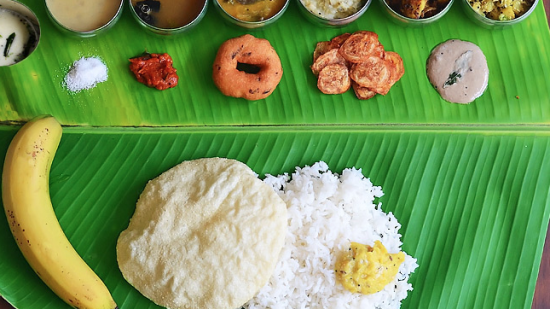
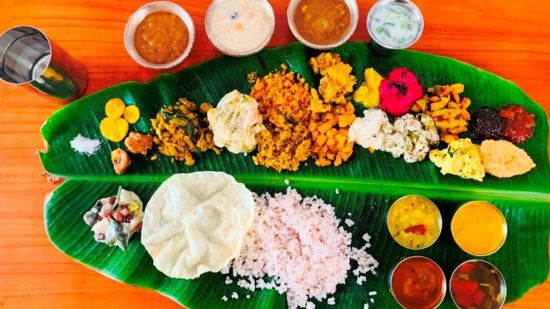
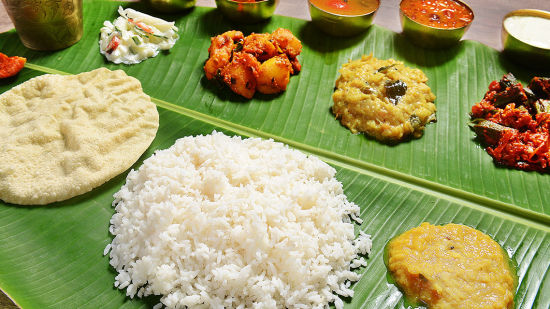
There can be no onam without the feast. The Onam Sadhya is a very special meal – a complex meal of 12 to 30 dishes and beautiful flavours.
The Onam Sadhya, or onsadaya as it is known, is a beautiful multi-course meal with a host of vegetarian dishes, each one as beautifully complex, or simple, as the other. The 30 dishes that comprise the Onam Sadhya is served on a banana leaf and eaten at lunch. The least you will eat is 12 dishes; the most is 30, served largely in temples.
The beauty of the flavours lies in the fresh ingredients used, the spices and the way they are cooked. The quintessential Onam Sadhya meals include papad or poppadum, banana chips, several pickles, avial, olan, kaalan, thoran mezhukkupuratti and dal topped with ghee or clarified butter, besides rasam, khichadi, coconut chutney and buttermilk. Not to forget that quintessential Kerala dessert, Payasam. The beauty of this meal not just lies in the way it is served, on green banana leaves, or the fact that you eat a virtual 25 dishes, each placed in a particular designated place on the leaf. It also lies in the fact that the meal is a sign that Keralites offer Mahabali, the mythical king who is said to return home for 10 days from his heavenly abode, that they are happy and prosperous and can afford a meal as elaborate as this.
The feasting begins with the ritual of offering the Onam Sadya items to Lord Ganesha. The festive meal begins with rasam (soup) and ends with payasam (dessert). The main dish is boiled rice served with uppari, sambar, aviyal, parippu, pullisseri, olan and pickles.
Chef Prakash, Executive Chef, Niraamaya Retreats offers the recipe of his favourite dish from the Onam Sadhya
The Onam Sadhya, or onsadaya as it is known, is a beautiful multi-course meal with a host of vegetarian dishes, each one as beautifully complex, or simple, as the other. The 30 dishes that comprise the Onam Sadhya is served on a banana leaf and eaten at lunch. The least you will eat is 12 dishes; the most is 30, served largely in temples.
The beauty of the flavours lies in the fresh ingredients used, the spices and the way they are cooked. The quintessential Onam Sadhya meals include papad or poppadum, banana chips, several pickles, avial, olan, kaalan, thoran mezhukkupuratti and dal topped with ghee or clarified butter, besides rasam, khichadi, coconut chutney and buttermilk. Not to forget that quintessential Kerala dessert, Payasam. The beauty of this meal not just lies in the way it is served, on green banana leaves, or the fact that you eat a virtual 25 dishes, each placed in a particular designated place on the leaf. It also lies in the fact that the meal is a sign that Keralites offer Mahabali, the mythical king who is said to return home for 10 days from his heavenly abode, that they are happy and prosperous and can afford a meal as elaborate as this.
The feasting begins with the ritual of offering the Onam Sadya items to Lord Ganesha. The festive meal begins with rasam (soup) and ends with payasam (dessert). The main dish is boiled rice served with uppari, sambar, aviyal, parippu, pullisseri, olan and pickles.
Chef Prakash, Executive Chef, Niraamaya Retreats offers the recipe of his favourite dish from the Onam Sadhya
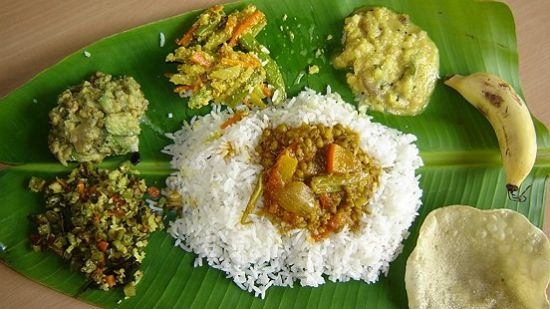
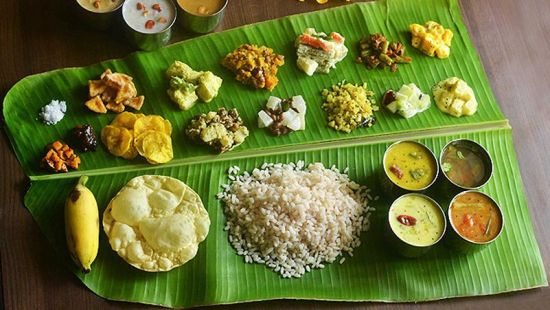
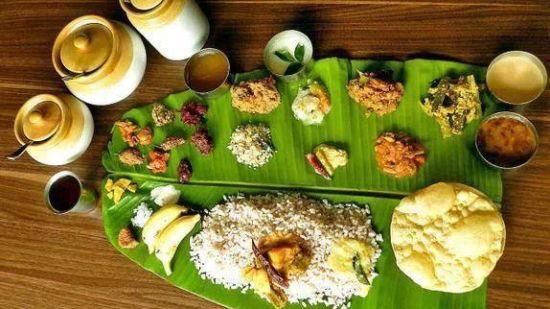
VADA KOOTTU CURRY
Ingredients for Vada
- Whole urad dal: ½ cup
- Crushed peppercorns: ½ tsp
- Salt: To taste
- Oil: For frying
- Onion: 20gm
- Green chillies: 2–3
- Crushed ginger: 2tsp
- Curry leaves: 1 sprig
- Turmeric powder: ½tsp
- Red chilli powder: 1tsp
- Coriander powder: 3tsp
- For the gravy
- Curry cucumber: 25gms
- Garam masala powder: 1tsp
- Coconut milk: 120ml
- Salt: to taste
- For the seasoning
- Coconut oil: 2 tsp.
- Mustard seeds: ½ tsp
- Urad Dhal: ½ tsp
- Dry red chillies: 3-4
- Shallots: 15gm
- Curry leaves: a sprig
Method
- Soak the urad dal for 3-4 hrs, drain the water and grind the soaked urad dal in a blender adding salt to a fine thick paste. Add only very little water. The batter should be thick and not watery
- Add ½tsp. crushed peppercorns and enough salt to the batter
- Heat oil in a deep pan. Make small balls with the batter. The batter should be sticky, so you could grease the palm of your hands with water and make the balls
- Drop the balls into hot oil; deep fry it till it turns golden brown in colour and keep aside
- Heat coconut oil in a pan and add onions, green chillies, crushed ginger, curry leaves and little salt till the onions are light gold in colour
- Add turmeric powder, chilli powder and coriander powder. Sauté until they lose their raw smell. Add cubed curry cucumber. Mix well and cook for a couple of minutes
- Add thin coconut milk and salt to taste. Cover and cook until the cucumber are cooked at medium heat
- When the curry is read, add garam masala powder, thick coconut milk and a few curry leaves. Bring to a slow boil
- Add the fried vadas and mix well. Check and adjust salt
- Remove it from heat and keep covered for some time. The fried vadas will absorb some of the gravy
- Heat another frying pan, pour oil, add mustard seeds, urad dhal, shallots, dry red chillies and curry leaves and allow it to splutter
- Now add the seasoning to the koottu curry. This curry tends to thicken over time